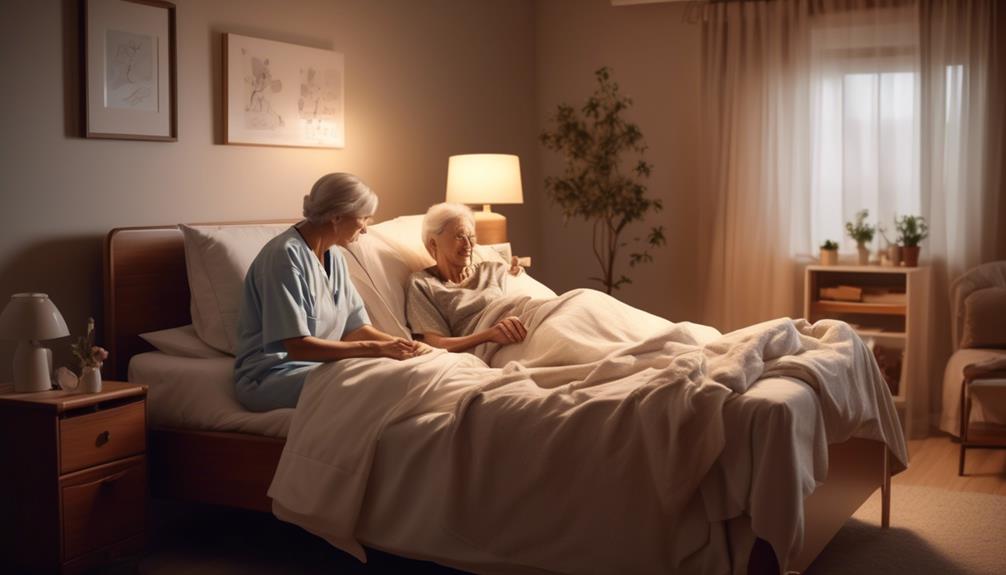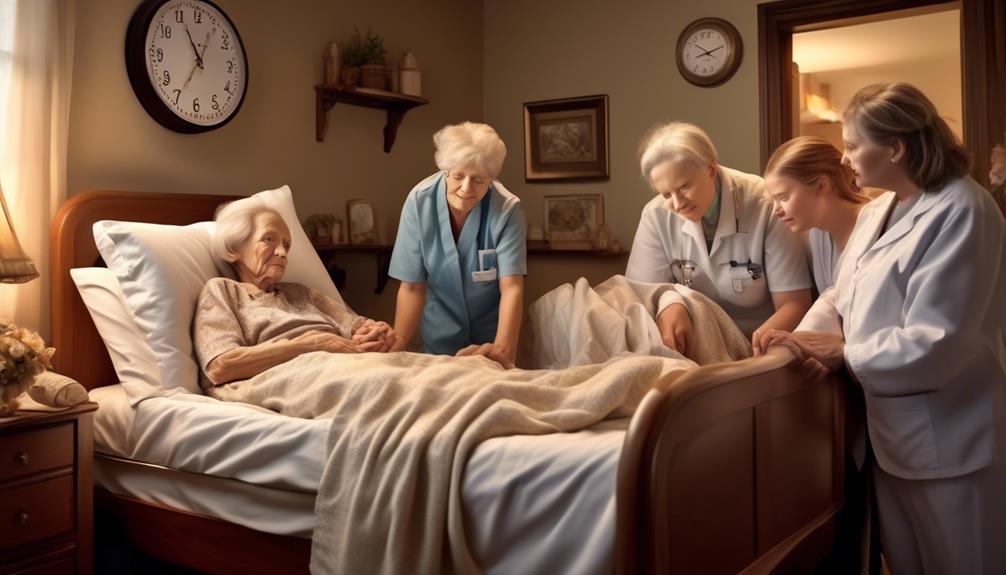Have you ever wondered if hospice provides 24-hour care at home?
The answer may surprise you. While hospice care is generally not set up for round-the-clock assistance, there are exceptions that come into play when patients require more intensive care due to acute medical needs or symptom management.
This nuanced approach to providing continuous care sheds light on the complexities of end-of-life support and the delicate balance between comfort and medical necessity.
Understanding the ins and outs of 24-hour care in a hospice setting can offer valuable insights for families navigating this challenging time.
Key Takeaways
- 24-hour hospice care focuses on acute symptom management at home.
- Eligibility criteria include the need for continuous skilled nursing care.
- Funding options include private pay, Medicaid waivers, and Medicare's hospice benefit.
- Alternatives to 24-hour care include inpatient hospice facilities for complex needs.
Understanding Hospice 24-Hour Care Coverage
In hospice care, we ensure 24-hour coverage at home through continuous care services tailored to support patients experiencing acute symptoms that demand close monitoring and specialized care. This continuous care in hospice offers skilled nursing and support round-the-clock, focusing on managing symptoms and enhancing comfort in the familiar setting of the patient's home. Our goal is to provide end-of-life care that prioritizes the quality of life for individuals facing terminal illnesses. By delivering intensive support and medical interventions at home, we aim to prevent unnecessary hospitalizations and allow patients to receive the care they need in a place that brings them comfort.
Continuous care services in hospice play a crucial role in addressing crises and acute needs promptly, such as uncontrolled pain or breathing difficulties. By offering 24-hour care, we ensure that patients have access to the specialized attention required during challenging times, emphasizing compassion, empathy, and a commitment to supporting individuals through their end-of-life journey.
Eligibility Criteria for 24-Hour Care

Understanding the criteria for eligibility for receiving 24-hour hospice care at home is crucial for ensuring that patients with acute symptom needs receive the necessary support and medical attention in their familiar environment. To qualify for around-the-clock care, patients must meet specific criteria for acute symptom management, necessitating continuous skilled nursing care. When routine visits are insufficient to manage severe symptoms at home, 24-hour hospice care becomes essential. This level of care provides medical support for patients with acute needs, ensuring comfort and effective symptom control. Hospice covers 24-hour care at home when patients require constant monitoring and interventions for symptom management.
| Eligibility Criteria for 24-Hour Care | Description |
|---|---|
| Continuous Skilled Nursing Care | Patients must require ongoing skilled nursing care for acute symptoms. |
| Acute Symptom Management | Specific criteria for managing severe symptoms are necessary for eligibility. |
| Around-the-Clock Care | 24-hour care is provided when routine visits are insufficient for symptom control. |
Funding Options for 24-Hour Care
What're the available funding options for obtaining 24-hour care at home for hospice patients?
When seeking continuous care for a loved one at home, various funding options can help alleviate the financial burden. While hospice typically doesn't cover 24-hour care, there are alternative avenues to explore.
Private pay services offer a direct payment option for families looking to secure round-the-clock care. Long-term care insurance policies can also provide coverage for extended care needs, including 24-hour assistance at home. Additionally, Medicaid waivers may be available to help cover the costs of care for eligible individuals.
It's important to note that Medicare's hospice benefit is designed for intermittent care rather than continuous 24-hour assistance at home. Families navigating the complexities of funding 24-hour care can benefit from researching these options and consulting with professionals to determine the best course of action to ensure their loved one receives the necessary support.
Pros and Cons of 24-Hour Care at Home

Exploring the benefits and challenges of providing 24-hour care at home for hospice patients offers valuable insights into the care options available during this critical time.
- Continuous Medical Supervision: 24-hour care ensures acute symptoms and end-of-life issues like pain management and breathing difficulties receive immediate attention.
- Support from Hospice Professionals: Nurses and other hospice staff provide around-the-clock assistance, offering comfort care and medical support.
- Bereavement Counseling: In addition to medical care, continuous care services often include emotional support and counseling for both patients and their families.
- Consideration of Alternative Care Options: Hospice organizations may suggest alternative end-of-life care if providing 24-hour care at home becomes physically or emotionally taxing on the patient or caregivers.
Providing 24-hour care at home can be physically and emotionally demanding, but with the support of dedicated hospice professionals, it can offer comfort and assistance during a challenging time.
Alternatives to 24-Hour Hospice Care
When considering hospice care options, it's important to explore alternatives to 24-hour care at home for patients who may require more intensive medical supervision and support. In cases where individuals have complex needs that necessitate a higher level of care, transitioning to inpatient hospice care facilities can provide the continuous monitoring and specialized support they require. These facilities offer round-the-clock supervision and medical support, ensuring that patients receive the appropriate level of care for their evolving medical needs.
| Benefits of Inpatient Hospice Care | Description | Importance |
|---|---|---|
| Round-the-clock supervision | Ensures constant medical oversight | Critical for patient safety |
| Specialized care | Tailored support for complex needs | Addresses specific challenges |
| Continuous monitoring | Regular assessment and symptom management | Ensures timely interventions |
Frequently Asked Questions
What Is Continuous Home Care Regarding the Hospice Benefit?
Continuous home care is a level of hospice support offering 8 to 24 hours of assistance daily in the patient's home. It's crucial during acute symptom episodes needing close monitoring to prevent hospitalization. This care, delivered by hospice professionals, ensures patient comfort and symptom management.
It's a vital resource during crises when routine visits aren't enough. Patients benefit from intensive home care, addressing complex medical needs and providing comfort during difficult times.
What Is Usually Not Included in Hospice Care?
Usually, hospice care focuses on comfort and quality of life for patients with terminal illnesses. It often includes pain management, emotional support, and assistance with daily activities. However, hospice care typically doesn't cover emergency room visits, hospital stays, or certain non-terminal illness-related treatments.
Our goal is to provide compassionate care tailored to the individual's needs while respecting the boundaries of hospice services.
How Many Times a Week Does Hospice Come?
We understand the importance of knowing how often hospice care is typically provided.
The frequency of hospice visits can vary based on the patient's needs and care requirements. Patients may receive intermittent visits a few times a week or even daily caregiver support.
The hospice team determines the level of care needed and adjusts the visit schedule accordingly to ensure the patient receives the best possible support.
How Long Before Death Is Hospice Care at Home?
Before death, hospice care at home can begin when patients require continuous support for symptom management. This care focuses on addressing acute symptoms like pain, breathing difficulties, or severe distress.
Hospice professionals, including nurses, can provide 24-hour support to manage end-of-life symptoms effectively. This continuous care service helps patients remain comfortable and supported during their end-of-life journey at home.
Conclusion
In conclusion, while hospice care typically doesn't cover 24-hour care at home, there are situations where continuous care may be provided for those in need of intensive symptom management or acute medical attention.
It's important to discuss all options with your healthcare provider to ensure the best possible care for your loved one.
Remember, the goal of hospice care is to provide comfort and support during a difficult time, and 24-hour care can help achieve that goal.









